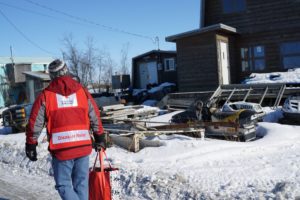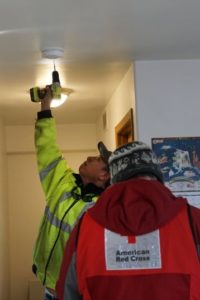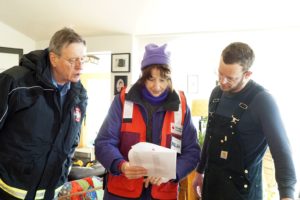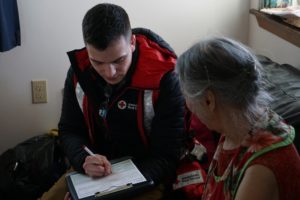With overcrowded homes and unconventional heating, Alaskan Red Cross volunteers face very different threats than their counterparts in the Lower 48 when it comes to our Home Fire Campaign (HFC).
 According to Alaska’s Red Cross Preparedness Specialist, Steven Fisher, many rural communities and villages have a population of less than 1,000 citizens with 20% living below the poverty line. This creates a unique working dynamic for Alaskan volunteers. Along with having to face the freezing temperatures, many volunteers must travel on a small transportation plane, snowmobile, sled and also walk to reach some Alaskan villages.
According to Alaska’s Red Cross Preparedness Specialist, Steven Fisher, many rural communities and villages have a population of less than 1,000 citizens with 20% living below the poverty line. This creates a unique working dynamic for Alaskan volunteers. Along with having to face the freezing temperatures, many volunteers must travel on a small transportation plane, snowmobile, sled and also walk to reach some Alaskan villages.
Despite Alaska accounting for 20% of the continental United States, Alaskan communities require specific efforts from the Red Cross that compare to no other climate in the U.S. Unfortunately, because of the climate, geographic isolation, older homes, and poverty rates, it is not only more difficult for volunteers to reach these communities, but it’s also much easier for disaster to strike.
With such small communities, the Red Cross values of neutrality and universality are vital for engaging within the remote villages. For many communities, the predominant languages include Yupik or Inupiaq, whereas English is secondary.
 “With this awareness, we enter every home with respect, curiosity and an attitude of no judgment,” said Steven. “We also need to be flexible. If homes or communities are engaged in subsistence livelihoods (fishing, seal-caribou-whale hunting, moose harvest, berry picking), we respect these activities and work with the schedules of our guides and community members. Likewise, we know that our departure flight is always ‘weather permitting’ and pack extra food if we are stuck for the day. As we do the [smoke alarm] installations, we try to tailor our home fire safety information to their specific context, gather our paperwork in communities with few or little known addresses, and announce the Home Fire Campaign via VHF radio to ensure anyone who wants an alarm has the chance to get one.”
“With this awareness, we enter every home with respect, curiosity and an attitude of no judgment,” said Steven. “We also need to be flexible. If homes or communities are engaged in subsistence livelihoods (fishing, seal-caribou-whale hunting, moose harvest, berry picking), we respect these activities and work with the schedules of our guides and community members. Likewise, we know that our departure flight is always ‘weather permitting’ and pack extra food if we are stuck for the day. As we do the [smoke alarm] installations, we try to tailor our home fire safety information to their specific context, gather our paperwork in communities with few or little known addresses, and announce the Home Fire Campaign via VHF radio to ensure anyone who wants an alarm has the chance to get one.”
Because of their geographical isolation, the cost of living for Alaskans is very high with many of their heating bills rising up to $1,500 a month due to the cost of fuel. In many villages, multiple generations of families often share a single home with their pets as a means of survival. With the flurry of so many lives in one home, Alaskan homes are at greater risks for accidents.
In the rural communities of Alaska in particular, many homes use ovens, open fires, and candles to keep heat flowing throughout the home instead of a traditional heating system. With these methods, there are greater risks of fires and other home emergencies which can quickly turn into fatalities. Being in more rural areas also makes it harder for help to come in a timely manner, so many fires are put out by volunteers with extinguishers.
I n an effort to combat fires as a part of the Home Fire Campaign, Alaskan Red Cross volunteers spread out around the state in an effort to keep communities safe and unharmed.
n an effort to combat fires as a part of the Home Fire Campaign, Alaskan Red Cross volunteers spread out around the state in an effort to keep communities safe and unharmed.
Devoted volunteers Jim and Melba have helped with the execution of our HFC by installing smoke alarms in rural Alaskan homes. After working at the Red Cross Southeast Michigan chapter, they moved to Alaska intent on seeing all of its communities.
Melba, a nurse, said, “ I like to learn about different cultural, medical healing processes… how other cultures address healing and wellness.”
Jim and Melba worked restlessly and diligently through various communities in Alaska in the hopes that their efforts could prevent a tragedy.
In Bethel, Alaska, Jim, Melba, Steven, and other volunteers partnered with the Bethel Fire Department to install smoke alarms, draw out escape plans, and assess any other possible safety hazards.
 After two fire fatalities struck the community in the months prior, the smoke alarm installations represented something more than just a safety precaution, they show how quickly an accident can turn into a tragedy.
After two fire fatalities struck the community in the months prior, the smoke alarm installations represented something more than just a safety precaution, they show how quickly an accident can turn into a tragedy.
“When we are welcomed into a home, we first share basic information about the smoke alarms we are installing,” said Steven. “In the past, volunteers have also attempted to spot various fire hazards that have included kindling gathered too closely to wood stoves, matches left on the floor, or blocked windows to let residents know about the risk. We share the basics of creating a home fire escape plan, and if children or elders are present, we invite them to draw out the initial plan. In addition, we have taken flood safety and winter storm safety checklists to supplement any fire safety information.”
Engaging with the children and elders of the home proves to be an extremely important task because they are more vulnerable if a disaster strikes the home. Because of this, the HFC team works closely with them to guarantee that they have a reasonable, safe and quick escape plan in case there is an emergency.
In an ongoing effort to reduce death and injury from home fires, the Red Cross Home Fire Campaign is hosting a series of installation and fire safety events across the country. Red Cross volunteers, along with fire departments and other partners, canvass high-risk neighborhoods, installing free smoke alarms, replacing batteries in existing alarms and helping families create escape plans. Since 2014, the Red Cross Home Fire Campaign has saved at least 258 lives and installed more than more than 886,000 smoke alarms in cities and towns across the United States.
Learn how you can help us Sound the Alarm to #EndHomeFires this fall.
